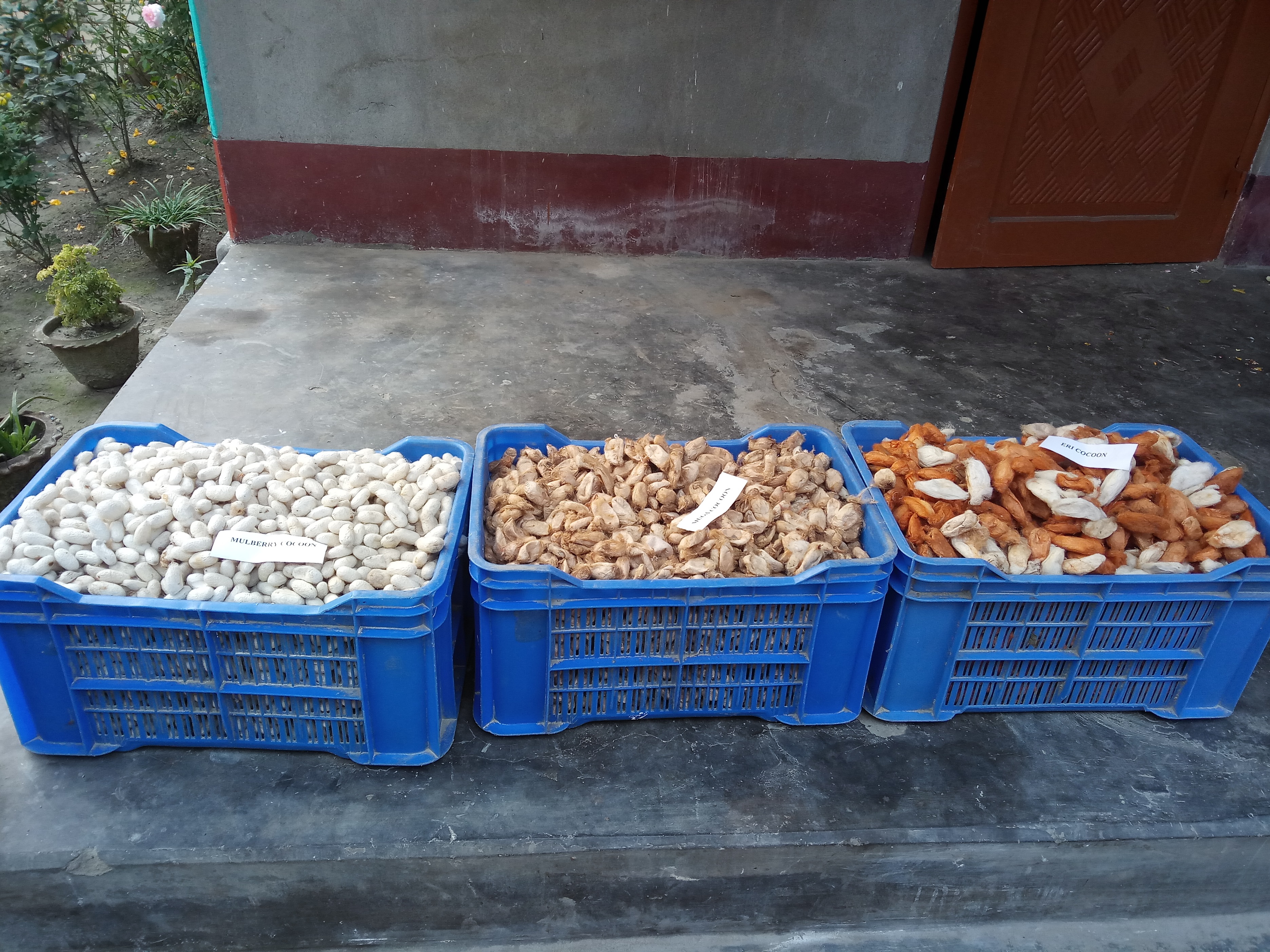- Muga silkworm, revered in Assam, and from which the globally famous ‘Assam silk’ comes, is endemic to the northeast region in India.
- Many farmers are putting off silkworm rearing by 10 to 15 days to avoid high temperatures during the commercial crop season from mid October to mid November.
- Genomic boost offers hope for increasing resilience and raw silk production.
Abnormal temperature fluctuations have thrown Manjita Basumatary and her fellow silk farmers from Assam in a tizzy. The rearers of the famed golden muga silk have had to shift the month-long rearing sessions by about 10-15 days to stave off climate-related silkworm deaths, even as the industry pushes on to ramp up production.
“The muga silkworm performs best in the temperature range of 25-27 °C and humidity of 75-85 percent. Generally a temperature range minimum of 15 °C and a maximum of 33 °C is considered as the range of temperature suitable for muga silkworm rearing. Beyond these two ranges, mortality of muga silkworm increases,” said Kartik Neog, a scientist with the Central Muga Eri Research & Training Institute (CMER&TI), while at Biodiverse 2018, a conference organised by IIT-Guwahati.
Muga, revered in Assam and globally famous as ‘Assam silk’, is unique to the northeast region in India. The state is also a major producer of another sartorial icon, the eri or enda silk. Apart from the more traditional use as a textile, silk is also a source for novel biomaterials, with applications in skin care, tissue engineering and the like.
Activities such as weaving, winding, sizing, warping and beaming of yarn provides livelihood to nearly 185,000 families in Assam, with women forming 65 percent of those making a living from silk rearing and spinning activities, say experts.

Despite acquisition of a Geographical Indication (GI) tag signifying the uniqueness of the silk from the area, this silkworm and the associated industry remains vulnerable. Widespread use of pesticides in neighbouring tea gardens, pests and diseases, as well as global warming imperil the silkworm’s survival, according to Neog.
Deforestation and rapid proliferation of small tea growers in upper Assam has led to shrinkage of traditional muga plantation. Also, the muga silkworm (Antheraea assamensis) is reared outdoors, and exposure to even the slightest change in temperature and humidity can wreak havoc – the impact of global warming coupled with climate change on the growth of the industry cannot be ignored, said Neog.
Shifting of the rearing season
During the last few years, rearers like Basumatary, a native of the Bodoland Territorial Council, have been putting off rearing during the commercial ‘Katia’ crop season (from mid-October to mid-November) by 10-15 days, to avoid high temperatures.
“If rearing of muga silkworm is started from last week of October (instead of mid-October), then the temperature and humidity range will be within the desirable limit and rearing performance will be better. Similarly, to avoid high temperatures during the actual Jethua commercial crop season, (i.e. during mid of May to mid June), the rearing may be started from first week of May,” explained Neog.
“It is very difficult to maintain the silkworms when the temperature goes above 30 degree Celsius. During June to September the temperature can also shoot up between 30 to 40 °C,” Basumatary says.
An analysis by the Indian Meteorological Department indicates that between 1950 to 2010 the mean temperature in Assam has shot up by 0.01 °C per year. There is also an increase in temperatures across seasons, with pronounced warming in post monsoon and winter temperatures.

Worry is writ large on Basumatary’s face as the Bodoland Territorial Area Districts enjoys the unique distinction of producing all the three varieties of commercially exploited natural silks— eri, muga and mulberry. Most importantly, for her and the rest of the womenfolk, silk rearing is a source of empowerment.
Using science to meet silk targets
The Central Silk Board (CSB) targets a production of 470 tonnes as per its Vision 2030, which is slightly more than double the current yield. “The expected production at present growth rate (4.72 percent) is 309 tonnes. We need to bridge the gap,” said Neog.
Alignment of the Assam silk industry’s production to the CSB target, also means combatting disease and pest infestations that ravage the rearing of the seed crop (silkworm eggs). The seed crop is subjected to viral, bacterial, fungal and protozoan diseases that result in heavy crop losses, going up to 40 percent for individual diseases.
“Around 30-35 percent of worms die due to microbial diseases on an average in a year. But, during hot humid seasons, the loss may be very high, which may extends up to 80 percent. The silk yield can be doubled if diseases are checked. We need muga silkworm breeds resistant or tolerant to these diseases. Also, looking into the gradual increase in the temperature due to several factors, it necessitates development of muga silkworm breeds which can withstand extremes of temperature ranges, whether it is high or low,” Neog added.
To that effect, the institute has recently developed two new muga silkworm races designated as CMR-1 & CMR-2 that are under trial and have not yet been released to the farmers for commercial use.
“Multiplication of the breeds for conducting multi-locational trials is under progress and will be taken up very shortly. Hence, it is now too early to speak about its resilience,” Neog explained.
The Assam sericulture and forest departments and Central Silk Board are setting up the first in situ conservation site in Golaghat district to conserve muga silkworm in its natural habitat.
In parallel, experts from IIT Guwahati’s Bioengineering Research Laboratory (BERL) have also taken a crack at decoding the mitochondrial genome of the muga silkworm. Using a combination of next-generation sequencing technology and computational biology tools for the experiment, they have decoded the complete mitochondrial genome of muga silkworm for the first time.
The decoding of mitochondrial DNA sequence would help in designing new experiments for improving climate resilient muga strains.

“Though the current climatic conditions may be grim for Assam, a remedy may be available. Traditionally, Jethua ((May-June) and Kotia (October-November) are the only crops used for commercial production. However currently it has been observed that winter is becoming the best yielding season for muga silk. BERL team believes that there is a tremendous possibility of increasing the yield of winter muga crops by mitogenome engineering to accelerate thermogenesis for adapting the muga silkworm to lower temperatures,” says study author Deepika Singh.
There are indications that in the near future, areas with cooler climates may surpass Assam in muga silk production, acknowledges Utpal Bora, a professor at BERL and study co-author. On the other hand, unconfirmed reports indicate that the winter muga crop is performing better than earlier due to an increase in average temperature, Bora added.
“This seasonal loss and gain is a new phenomenon and have puzzled both the muga farmers and scientists. There are initiatives in the pipeline to create muga silkworm sanctuaries in cooler areas outside Assam which is a welcome step,” Bora said.
However, he warns, this could be a loss for the traditional muga farmers and the industry itself.
“The cultural value muga has for its home state, which possesses a GI for it, is certainly great. A timely and rapid initiative is required to safeguard the interest of the muga cottage industry form decimation by climate change,” stressed Bora.













